RDP 8704: The Role and Consequences of Investment in Recent Australian Economic Growth 5. Influences on Private Capital Accumulation
April 1987
In Section 3 we noted that the broad empirical relationships observed among capital, labour, output and factor prices were, perhaps surprisingly, broadly consistent with the existence of an aggregate production function and competitive factor markets, although there have been some periods during which actual factor payments have deviated widely from the competitive solution. As mentioned in that section, these relationships imply the existence of a production function but they do not necessarily tell us anything about why labour and capital evolved as they have done over the past two decades or so.
The most striking feature of the period under consideration is the trend increase in the capital intensity up to the late 1970s and the reversal of that trend since the early 1980s. This section considers some of the factors that may have influenced this outcome. Since the emphasis of the section is on the private sector's decision making processes, the analysis is restricted to private sector investment, excluding dwellings.
5.1 Neoclassical investment theory
Neoclassical investment theory starts from rigorous microeconomic foundations. The typical approach posits that firms choose inputs of capital and labour so as to maximise the present value of expected profits. The objective function can be expressed in the following terms:
where r is the firm's discount rate, p, w and pk are the prices of output, Q, labour, L, and investment goods, I, while λ1 , and λ2 are lagrange multipliers, and F(.) is a well-behaved production function.
The solution to this maximisation problem is a set of demand functions for capital and labour services and a supply function for output. The solutions are functions of relative prices, both current and future; that is, they depend on the entire expected time sequence of relative prices.
There have been many attempts to estimate Investment equations derived directly from the neoclassical foundations sketched above.[16] Their success has been less than impressive. Hawkins (1979) outlines a number of reasons why it is difficult to apply neoclassical models to the 1970s. Most studies have focussed on the demand for investment, without much reference to the supply of investment goods or to demand for and supply of finance.
One study which takes a more aggregative, equilibrium approach to these relationships is that by Kohli and Ryan (1985) which integrates production decisions with portfolio decisions. They argue that the stock of capital is given at any point in time so that, under competitive conditions, the rental price (user cost) of capital will tend to equal its marginal product. On this basis, they construct an integrated model of investment behaviour, taking into account the decisions to own, use and produce capital goods.
The great difficulty with empirical implementation of the neoclassical model, however, is the dominance of future expectations coupled with their lack of acceptable empirical measurement. As pointed out by Carmichael (1979), the demand functions derived from the neoclassical model can be interpreted as incorporating most ad hoc explanations of investment. For example, profits play a central role in the optimisation process of the neoclassical firm, but so too do the cost of capital, relative prices, expected output and so on. In a sense, most of the ad hoc or simplified models of investment can be interpreted as special cases of the more general neoclassical model, with an emphasis on empirical expedience. This feature of the neoclassical model as “nesting” more empirically-oriented approaches is both a strength (because of its generality) and a weakness (because it fails to yield unambiguous testable implications).
5.2 Some empirically-oriented explanations of investment
One of the earliest theories of investment behaviour, the accelerator approach, links the level of investment with changes in the rate of growth of output. Since investment generates changes in the capital stock, and output is related to the level of capital rather than its rate of change, the simple accelerator explanation relies on growth in output to stimulate investment. In his extensive survey of the literature Hawkins (1979) found that, until the early 1970's, business investment fitted an accelerator mould. Hawkins cites the insignificance attributed to other variables, such as tax incentives, as evidence that demand influences outweigh other factors. However, he found that the relatively simple accelerator mechanism no longer seemed appropriate in the mid to late 1970s. This was reflected in the number of studies which attempted to take into account additional factors including the rise in real wages, movements to equal wages, higher inflation and exchange rate movements.[17] Even more sophisticated versions of the accelerator hypothesis incorporated capacity constraints and limited substitution between labour and capital.
Figure 5.1 (reproduced from EPAC (1986)) shows growth in business-fixed investment during a number of economic upswings. As illustrated by this graph, upswings in economic activity have been associated with a wide variety of investment profiles. While the evidence does not support a simple accelerator relationship between investment and cyclical growth, Stegman (1982) has found evidence of an accelerator effect in a more complex model incorporating a profitability constraint. However, Stegman concluded that his approach was only a “qualified success” after finding some evidence that investment was constrained by profitability from late 1970 to the end of 1971 and during 1975.
One empirical relationship that has received a lot of attention in a number of countries is that between investment and a measure known as Tobin's “q”. This measure is constructed as the ratio of the market value of existing capital to its replacement cost. When this ratio is low, existing capital is cheap relative to purchasing and installing new capital. Under these circumstances, investors have an incentive to take over existing enterprises. Correspondingly, when the ratio is high, investors have an incentive to install new equipment.[18]
GROWTH IN BUSINESS FIXED INVESTMENT
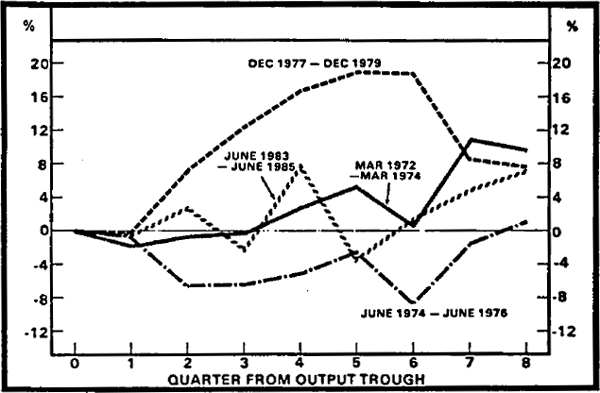
Figure 5.2 shows a measure of Tobin's q, graphed against business investment as a ratio to business capital stock. Allowing for a lag of at least a year between the emergence of the incentive to invest and the actual installation of capital, the graph suggests a fairly close relationship along the lines predicted by Tobin. The period since the start of the 1980s, however, does not fit well with the general picture; in that period, q indicates a strong rise in the incentive to investment while actual investment, as a proportion of the private sector's capital stock, has been falling.
There is little agreement about how to measure the cost of employing capital. In a wide range of empirical work in Australia (see, for example, EPAC (1986) and the works cited by Hawkins (1979)) the cost of capital has been based on its opportunity cost; namely, the rate of return on government securities.
INVESTMENT AND TOBIN'S q RATIO
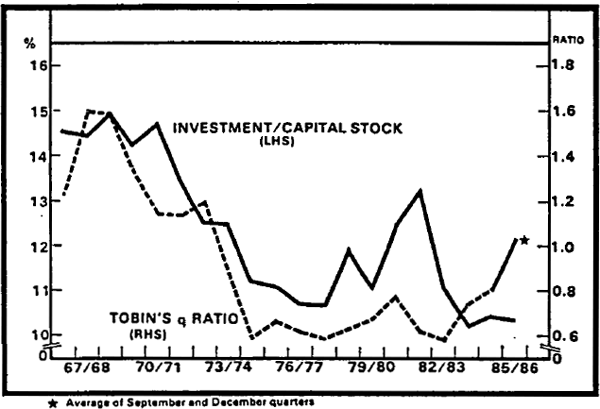
EPAC (1986) have suggested a measure of incentive to invest based on the ratio of the expected rate of return on capital to the opportunity cost of funding the capital expenditure. In concept, this measure is quite similar to Tobin's q since it incorporates many of the same factors. In practice, the two are quite different, largely as a result of the data used. In particular, the EPAC measure of incentive to invest uses a long-run measure of expected returns based on their AMPS model.[19] Tobin's q, on the other hand, is based on data from a large sample of listed companies. This tends to reduce the variance of the EPAC series relative to Tobin's q.
Figure 5.3 shows the ratio of investment to capital against the EPAC variable. Again, the relationship is as predicted and quite credible. In particular, the EPAC measure explains the lacklustre performance of investment over the past two years better than does Tobin's q, though the latter provides a better explanation of the early to mid 1970s.
In comparing the Tobin and EPAC measures of incentive to invest it is useful to think of Tobin's q as reflecting expected profitability and the cost of equity-funded investment, while the EPAC measure uses debt as the relevant financing instrument. In the past year or two, real interest costs have risen, while the cost of equity capital has fallen.
INVESTMENT AND EPAC INCENTIVE RATIO
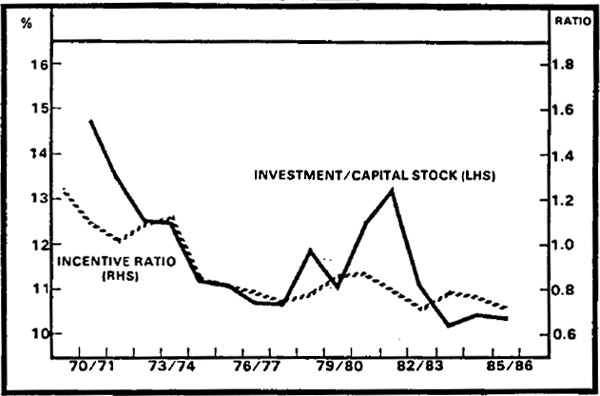
Both Tobin's q and the EPAC incentive ratio are essentially forward-looking concepts. An often-quoted determinant of investment that is less oriented to expectations is current profits. Current profits generate readily accessible funds for investment and, at times, may be a guide to future profitability. The importance of profitability has been highlighted by Gruen (1986 p.192) who argues that:
Allowing the profitability of economic activity generally to improve and, in the process, encouraging higher rates of capital formation is probably the single most important step we could take to improve our lacklustre per capita growth performance.
Figure 5.4 shows business-fixed investment as a ratio to business capital graphed against the after-tax corporate profit share (including financial enterprises). Again, the fit is quite creditable and, as with Tobin's q, the relationship fits less well since the beginning of the 1980s.
While it is difficult to determine why the measures of incentive to invest and profitability fit the pattern of investment less well in some periods, part of the answer may be incorporated in the extent of capacity utilisation. If the data in Figure 3.2 can be taken as indicative of trends throughout the economy rates of utilisation of existing capital are currently still quite low by historical standards. This may have contributed to recent slow growth in investment. This is in contrast to the pattern evident throughout the investment boom of the late 1960s, during which existing capital was more full utilised.
INVESTMENT AND PROFITABILITY
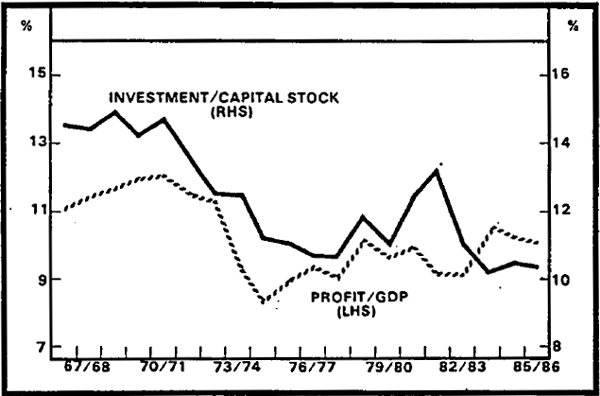
Another factor often regarded as a key determinant of investment is relative prices. Of particular relevance is the price of capital relative to the price of labour; when labour becomes more expensive, there is an incentive to substitute capital for labour (and vice versa). The cost of employing labour is reflected primarily in direct wage and on-costs (workers compensation, payroll tax and so on). Figure 3.1 in Section 3 provides a widely-used measure incorporating these factors.
Wage costs are relevant to the choice between capital and labour in producing any given desired output. In a competitive environment, where capital is mobile internationally, the cost of labour in Australia relative to that in our major competitors abroad can also influence the level of investment. Figure 5.5 shows a measure of unit labour costs in major OECD countries relative to unit labour costs in Australia, adjusted for the exchange rate (an index of competitiveness), graphed against the performance of investment. As the index rises, Australian labour becomes more competitive relative to labour abroad. This should encourage investment in Australia. The relationship in Figure 5.5, is rather loose. However, a rough apportioning of the period into times of high and low competitiveness suggests that (with a lead time of about one year) high competitiveness correlates with rising investment and low competitiveness with falling investment.
INVESTMENT AND COMPETITIVENESS
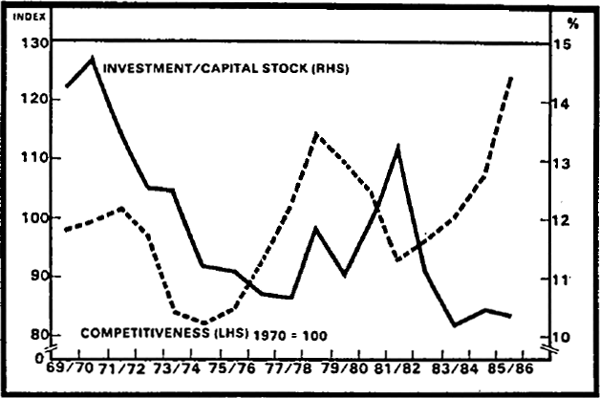
5.3 Determinants of investment
For any one or more of the factors listed above to qualify as major determinants of investment over the post-war period in Australia it would be necessary for them to have been largely exogenous over the period. There are, of course, few variables for which true exogeneity can be claimed. For example, the boost to wages in 1974 undoubtedly had an element of exogeneity but, for most of the period, it is unlikely that the behaviour of wages was not as influenced by capital accumulation as was capital accumulation by wages.
The same can be argued about profits and, to a lesser extent, about the cost of capital. In the case of capital costs, monetary and fiscal policy can at times impart a degree of independence. This occurs both through the impact of policy on the nominal interest rates of competing assets and through the impact of inflation on real rates of return.
This latter point has been somewhat controversial. According to the well-known Fisher theorem, real interest rates should be largely independent of the rate of inflation. Carmichael and Stebbing (1983) found, to the contrary, that in both the United States and Australia, the data were more consistent with the alternative hypothesis that nominal interest rates are largely independent of inflation, while real rates fluctuate inversely one-for-one with inflation. While they raised a number of caveats against using this relationship for projecting into the future, their results do suggest that, over the post-war period, the rate of inflation has been a major determinant of the cost of capital and, through it, the path of capital accumulation.
Accepting this line of argument would suggest inflation as a key factor in determining the capital intensity. But, even here, inflation would be no more than a proximate determinant of Australia's capital intensity, since inflation is itself an endogenous variable. The ultimate determinants of capital intensity would be the factors such as monetary and fiscal policy, world inflation and so on, that determine the rate of inflation in Australia over this period.
Of course, economic policies also respond to domestic developments. Nevertheless, there appears to be a case that the overall trend in capital intensity has been largely policy related. That is, the rise in capital intensity in the mid 1970s appears to have been associated with expansionary stabilisation policies that fueled inflation and reduced the cost of capital to historically low levels (by many measures, including that in Figure 3.1, the real after-tax cost of capital became negative in this period). Similarly, in the late 1970s and since the start of the 1980s, firmer policies have reined in the rate of inflation which, coupled with deregulation of interest rates, resulted in a higher cost of capital and quite probably through that channel, a lower capital intensity.
This general trend was punctuated in the early 1980s by the increase in capital intensity associated with the resources boom, which exogenously raised expected profitability relative to the cost of capital. The subsequent reversal of that increase in expected profitability has reduced the desired capital intensity relative to the cost of capital.
Footnotes
See for example, Mackrell, Frisch and Roope (1971), McLaren (1971), Hawkins et.al. (1972) Pagan and Gray (1983) Perazzelli and Perrin (1983) and various other publications on the Treasury's NIF model and the Reserve Bank's RBA1 and RBII models. [16]
See for example, Higgins et.al. (1976) and Sheehan et.al. (1979). [17]
For a fuller explanation, see Tobin (1969) and Dews (1986). [18]
See Murphy et.al. (1986). [19]
